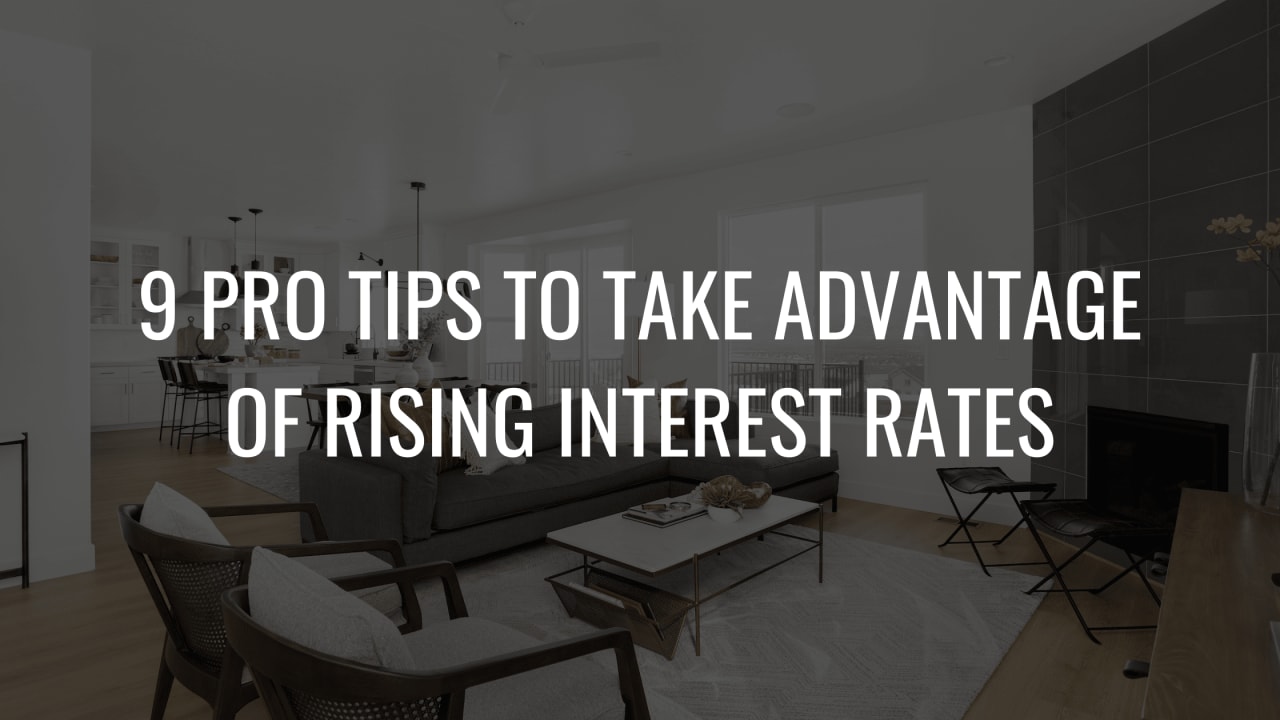I have been saying it for months: “Any shift in the market will likely be tied to rising interest rates.” Interest rates have risen, and market shifts are apparent, but this doesn’t necessarily have to be bad, especially for savvy buyers who understand the math and know how to use this opportunity to their advantage. Here are 9 ways to take advantage of the shift and make rising interest rates work for you!
1. Understand the math behind rising interest rates
Before we get into some creative strategies, let's look at the math to calibrate where we are. Mortgage interest rates have effectively doubled in the last couple of months.
Example:
A $900K loan at 2.5% interest on a 30-year fixed rate would cost $3,556/month or $42,672/ year
That same $900K loan at 5% interest for the same 30-year fixed rate would cost $4,831/month or $57,972/ year
Difference = $1,275/month or $15,300/year
(Both examples are Principal and Interest only.)
However, while we're talking about a 35% increase in principal and interest payments per year, we're not seeing or expecting a 35% drop in home prices in the Bay Area market. High demand and low inventory are still the reality of the market and will not likely change any time soon.
If you want to know more, look at some specific examples, and dive into the analytics of a specific market, check out our market reports. You can also book some time with me here.
2. Don’t try and time the market
If you’re one of those people who are waiting around for the prices to go down and the market to crash, stop trying to time the market; the shift that we're seeing now is because interest rates went up, and if you’re waiting, you’re effectively pricing yourself out of the market. Interest rates going up is not ideal when considering your monthly payment, but there are some great deals where you don’t have to purchase the home for as much. Interest rates can change, and if and when they go down, you can refinance and effectively lower your payment. (Especially if you buy a home at a discount).
3. Find a home where you can negotiate, and ask the seller to buy down the rate with credit in lieu of repairs
PRO TIP ALERT: Credits are given by the seller for several reasons during the transaction. A buyer discovers a new material fact about the property (that wasn’t previously disclosed), or perhaps you did your inspections on a property, and the inspection report returned with a $50k quote for repairs. Once a credit is negotiated, buyers can use that credit from the seller towards buying down the rate rather than having the seller do the repairs, effectively making sellers buy down the interest rate on the loan.
4. We see fewer multiple-offer situations
In our extremely competitive market(s) where inventory is low, buyers will still face multiple offer situations. It's always been a reality of the market when we have more demand than we do supply, especially in desirable areas and turnkey homes. However, we are noticing a trend where fewer buyers are in the market, resulting in less competitive multiple-offer situations where homes wouldn’t sell for as much over asking. Back in QT 1 and QT 2, where you might have been competing with 10-12 offers, there are only 4 or 5, which means that home isn’t going to go as high as the list price.
5. Keep an eye out for good deals in the form of stale listings and price reductions
Price reductions are an attempt from the seller to revamp interest when a home that has been sitting on the market for a few weeks doesn’t go into contract. Buyers can find a good amount of price reductions starting to happen.
For sellers out there, it's essential to price your home correctly from the start, ahead of the market, so that you generate enough interest to get an offer on your home in the first two weeks; after that, interest starts to die off, and buyers can feel pretty confident that there aren’t any offers on the table, which is an opportunity for a great deal and an opportunity and leverage to get into a contract with contingencies (less competitive offer).
6. Getting approved for a mortgage increases your chance of not overpaying and getting a home under contract: A bird in the hand is worth two in the bush
PRO TIP: Get approved for a mortgage from a lender and hunt for good deals, price reductions, and 30+ Days on the Market (DOM).
- Picture this: A buyer finds a great home that has been sitting on the market for 30 days where the seller just reduced the price, and that buyer writes a clean offer (non-contingent), and it’s the offer on the table! If you were the seller (assuming it's a fair price for the home), would you take the offer knowing that the buyer is a sure thing and the lender is guaranteeing to close?
- Now imagine that you're the seller and you get the same offer, yet that buyer hasn’t been approved for a mortgage yet; thus, they have a loan contingency (meaning their offer is contingent on them getting qualified for a loan). If you were the seller, would you accept the offer or wait to see if you could get something better? Most likely, the seller will tell the buyer to go get qualified for a loan and then come back with an offer. By the time the buyer comes back, that property may be sold.
7. Learn about niche loan products
There are tons of niche programs out there that work for all types of scenarios, and good lenders will take the time to understand your goals and help you pick a product that will work best for your real estate goals.
My favorite program is the Eagle Community Loan program through the First Republic Bank. In my opinion, it's the best program on the market for a 30-year fixed mortgage; currently, a 3.25% rate on a 30-year fixed rate, AND you get a 7K closing cost credit! Like any program, there are some restrictions and guidelines, and you check out all the homes that work for the Eagle Program here.
8. Write a compelling pre-emptive offer
Sellers are concerned about rising interest rates and market shifts, too. How do you use that to your advantage? Consider writing a “pre-emptive” offer!
What if you could identify a listing before it hit the market and write the seller a compelling offer before interest rates rose more, eliminating the concern about going to market and hoping for the best? What if you made an offer before the seller had to handle the hassle of getting their home ready for the market? There are many ways to create a win-win situation with off-market deals on pre-market listings.
9. Understand that rising interest rates are also coinciding with seasonality
Spring buyers are exhausted, and many families take time off their home search during the Summer. From a seasonality standpoint, agents can see the market slow down in July and August, with another small uptick in supply and demand around Labor Day weekend. Then, around mid-November, the market generally slows for both buyers and sellers during the holidays, then comes tax season, and the cycle repeats itself where it picks back up in the Spring.
Questions, Comments, or Concerns? Feel free to drop me a line!




